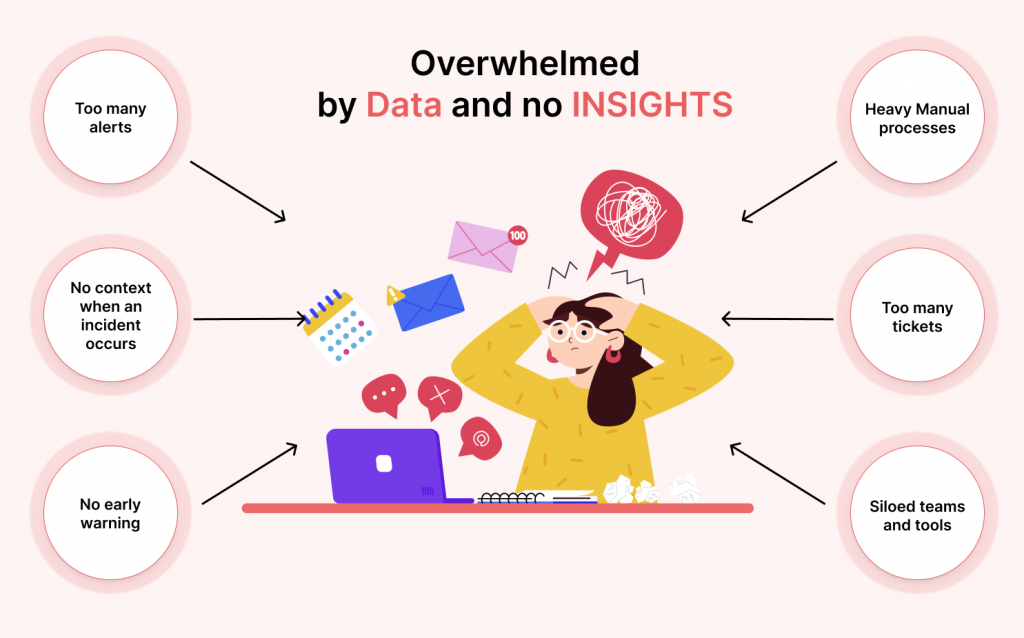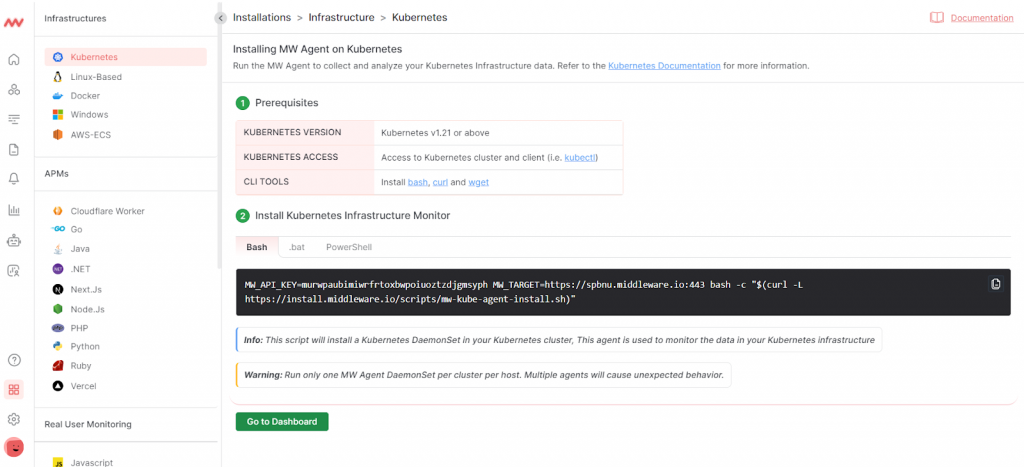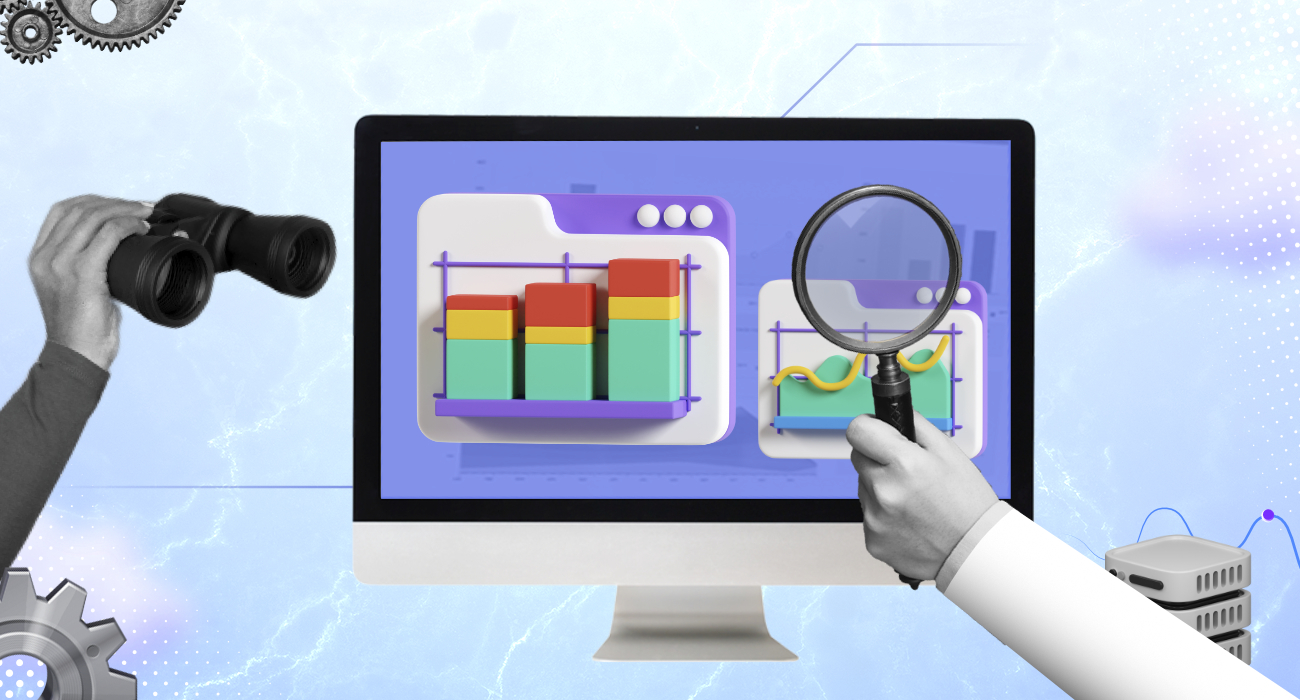Artificial Intelligence (AI), Big Data, Cloud Computing, the Internet of Things (IoT), and even Open Telemetry (Otel) are trends that have been around for years. However, 2023 was the year of transformation, as it was this year that these technologies truly made a sizable impact.
Since the amount of data collected, its usage, and use cases has increased significantly, 2023 also saw significant growth in the observability market. Hence, driven by the increasing adoption of cloud-native technologies and the growing need for real-time application insights, several observability trends will take center stage in 2024.
In this article, we will explore the top 10 observability trends expected to shape the future of technology in 2024.
But before jumping to the trends, let’s take a quick peek into the developments of 2023.
A look back at 2023: The year of AI & digital transformation
Fueled by the wider adoption of cloud and digital technologies, the year 2023 witnessed a rise in the digitally-native or cloud-native market. AI and automation were also a trending topic, with promises to replace human workers completely.
But despite its hype, there are several areas where these technologies need insights and optimization to be implemented in the real world. This is where observability provides a more realistic perspective. AI in observability holds the potential to revolutionize the field, and in 2024, the integration of AI and ML in observability is a rapidly evolving trend.
Here is a look at some of the observability trends that made headlines in 2023 and how they have evolved to define the future.
1. Developments and technological advancements
Organizations realized that manual processes alone couldn’t handle the vast amounts of data for observability and security. The increasing complexity of technology stacks and the surge of data from multi-cloud environments prompted them to seek more efficient ways to drive intelligent automation in 2023.
AI-powered observability platforms
Organizations in 2023 grappled with the sheer volume of data generated by complex tech stacks and multi-cloud environments. Manual processes simply couldn’t handle the load, leading to a surge in demand for intelligent automation.
This led to a transition to more holistic solutions, integrating observability, security, and business analytics. These AI-powered platforms automate tasks like anomaly detection and root cause analysis, freeing up valuable time for IT teams. Thus, organizations transitioned from isolated tools to AI-powered analytics platforms such as Middleware, DataDog, NewRelic, and others, converging observability, security, and business analytics.
Convergence and integration
As per a survey, 88% of respondents stated that their organization has become more welcoming and inclined to full-stack observability in the past year. Observability vendors responded by offering solutions that seamlessly integrate with security and business intelligence tools.
Open source projects
While commercial solutions offer robust features, open-source tools played a significant role in 2023. Tools like Prometheus and Grafana gained significant traction due to their flexibility, cost-effectiveness, and large user communities. These open-source solutions offer a viable option for organizations with budget constraints.
2. Adoption trends in cloud-native environments
The increasing adoption of cloud-native technologies like containers and Kubernetes presented unique challenges for monitoring and troubleshooting.
According to a report titled “The State of Observability 2024,” 88% of organizations mentioned the increasing complexity of their technology stack, making it even more challenging to track and gain end-to-end observability.
In response, observability solutions evolved to seamlessly integrate with container orchestration platforms, enabling:
- Automated monitoring: Observability tools can now automatically monitor dynamic service discovery and ephemeral resources within cloud-native deployments. This ensures consistent visibility into the ever-changing nature of these environments.
- Scalability: Modern observability solutions are designed to handle the scale inherent in cloud-native deployments, allowing for effective application monitoring even in large and complex environments.
This allowed automated monitoring of dynamic service discovery and temporary resources, ensuring visibility into the ever-changing nature of cloud-native deployments. As a result, applications could be monitored at scale in these environments effectively.
3. Cost analysis and financial optimization
In the face of economic uncertainties, optimizing the financial aspects of observability platforms became paramount. Here is a look at the key impacts of this:
Losses incurred due to no observability
The true cost of not having an observability solution can be significant. Downtime events can be extremely expensive, and according to a source, improved observability systems can reduce downtime expenses by 90%, bringing them down to $2.5M every year.
Observability spending increased
Organizations have begun to understand the true value of having end-to-end observability in their platform. A well-designed observability solution can deliver a significant return on investment (ROI) by helping to:
- Reduce downtime and improve application performance
- Identify and resolve issues faster
- Optimize resource utilization
- Improve developer productivity
Cutting costs by consolidating tools
CFOs focused on consolidating observability tools and identifying redundancies to reduce licensing costs. Collaborating with IT and operations teams, they prioritized observability investments aligned with strategic goals, ensuring efficient resource allocation.
4. Major industry funding, mergers, and acquisitions
The year 2023 also witnessed significant funding and mergers in the observability sector. The following are a couple of examples to note:
Rise of observability players
The overall observability market witnessed significant growth, with a growing number of vendors offering a wide range of solutions. According to a report by DevOps.com, observability companies (including security and APM firms) collectively raised nearly $2 billion in the past two years.
Here are some additional examples of funding activity in 2023:
Middleware raised seed funding to transform cloud observability
San Francisco, California, and Ahmedabad, India-based Middleware is a full-stack cloud observability platform designed to boost operational efficiency, minimize downtime, and enhance user experience.
Founded in 2022 by data experts from companies like Splunk, Segment, New Relic, and Acquire, the platform streamlines issue resolution for development and operations teams by consolidating metrics, logs, traces, and events onto a unified timeline.
In 2023, Middleware graduated from Y Combinator’s Winter 2023 and secured $6.5 million in seed funding, with support from 8VC, Fin Capital, Vercel CEO Guillermo Rauch, Tokyo Black, and other notable investors.
Acceldata’s funding and growth
Data observability startup Acceldata secured $10 million in an extension to its Series C round in 2023. This investment was allocated towards go-to-market efforts, mergers, acquisitions, R&D, and geographic expansion.
Mergers and acquisitions
The heightened activity in the observability market extended to mergers and acquisitions (M&A) as well. Here are some notable examples from 2023:
Cisco’s acquisition of Splunk
The industry witnessed a major shakeup, with Cisco acquiring Splunk for $28 billion. This move positions Cisco to offer a more comprehensive cloud management platform with integrated observability capabilities.
Bigeye’s acquisition of Data Advantage Group
Bigeye, a data observability company, acquired Data Advantage Group in 2023 to enhance its data lineage capabilities. This business deal enabled Bigeye to provide customers with complete visibility into complex data pipelines. The company’s strategy via this acquisition was basically to deliver end-to-end observability and automation solutions.
Rise of independent players
While consolidation is happening within the observability space, Datadog is carving a name as an independent player with a strong market presence. In 2023, Datadog acquired two companies: Codina and Actiondesk. Their continued success highlights the demand for best-in-breed solutions and the value proposition of independent vendors.
By 2024, observability spending is estimated to have surpassed $2.4 billion globally, and by 2028, it is projected to reach $4.1 billion. As businesses continue to invest in observability solutions, we can expect to see continued growth, innovation, and strategic consolidation in the years ahead.
Top 10 observability trends 2024
Here are the top 10 observability trends of the year that you must take note of:
1. Multi-cloud environment adoption
Organizations nowadays rely on adopting multiple cloud services, which has become essential for adapting to digital changes. According to a report by 451 Research, 98% of enterprises are using or plan to use at least two cloud providers, and 31% are using four or more. However, embracing it comes with navigating the roadblocks of managing applications across different providers and setups.
The complexity of these multi-cloud environments also makes it difficult for IT and security teams to ensure smooth user experiences. Additionally, providing good customer experiences while keeping data secure becomes a hassle.
Even with the included benefits of scalability and flexibility, maintaining control and visibility across these multi-cloud apps remains problematic for developers. Therefore, if companies continue to work with these systems, they must also plan to address incoming challenges associated with them.
“‘Multicloud environments’ and ‘cloud-native architectures’ are not just buzzwords; they are the reality of today’s complex and dynamic IT landscape. They enable developers, engineers, and architects to drive innovation, but they also introduce new challenges.”
Andi Grabner, Dynatrace DevOps Activist
2. Challenges brought by data overload
Data has truly become indispensable for the IT industry to make informed decisions and improve business developments. However, the rise in cloud-native technology stacks has flooded IT and security teams with overwhelming data sets.

A recent Oracle study discovered that increased data has resulted in a decision-making slump. 78% of workers may be overloaded with data from a growing number of sources.
Businesses that utilize traditional methods for managing logs and analytics struggle to keep up with rapid technological evolution and data overload. As a result, they often fail to derive actionable insights.
“From day one, we understood the scale we were dealing with. That’s why it took us almost a year and a half to establish a solid foundation for the product. We aimed to ensure that we could handle 10 to 20 petabytes of data across all platforms per month and scale accordingly.”
Laduram Vishnoi, CEO, Middleware
Moreover, the increasing costs of storing and analyzing data exacerbate the issues related to data overload. This forces IT teams to keep data for real-time analytics, unfortunately, often at the expense of valuable insights.
What’s more alarming is that organizations nowadays depend on an average of 10 monitoring tools. This makes managing multi-cloud environments a trickier business.
Hence, to tackle this issue, the IT industry needs to leverage software solutions, such as Middleware, that offer database monitoring features. Features like this can automate data management and analysis by tracking and measuring your database metrics.
3. Prioritization of data privacy and governance
One of the top observability trends of 2024 is that organizations are increasingly prioritizing data privacy and governance within their data observability developments.
“Data drives success, and it is the fuel for our engines. Because of this, it must be managed carefully to maximize its value and efficiency and to minimize the risks involved. I think about three core objectives that are necessary to achieve these goals: data stewardship, data governance, and data privacy and security.”
Lance Hayden, Vice President at Vericast
With evolving and stringent data privacy regulations, there’s a heightened focus on ensuring compliance and protecting sensitive information. Key strategies to confirm compliance with regulatory standards include the following:
- Implementing robust data anonymization techniques
- Monitoring data access and usage
- Maintaining comprehensive audit trails
By integrating these secure observability practices, organizations not only enhance their compliance needs but also help increase the confidence of their customers and stakeholders in their business tactfully. They also get to mitigate the risks associated with data breaches and regulatory non-compliance.
4. Increase in financial observability capabilities
Richard Hartmann, Director at Grafana Labs, sees a trend in FinOps: opting for a more data-driven approach. This is observed in parallel to businesses trying to maximize their financial resources.
This trend calls for using modern observability tools that can efficiently collect, store, organize, and analyze data. Companies that use such tools will be able to manage and optimize their spending habits and even earn a competitive edge in the market.
Furthermore, with improved financial observability tools, businesses would be able to directly correlate expenses to profit centers which will give them a detailed picture of how their organization is run.
Hartmann also stresses how critical it is to use real-time data from production systems. He believes that it will benefit in making well-informed decisions on expenditures.
Using this strategy, businesses may be able to make conscious choices that help them detour from the excessive savings department and successfully generate plenty of revenue.
5. Inadequacies of fragmented monitoring and analytics
Due to ignorance, many IT organizations continue to rely on disorganized cloud monitoring tools and manual analytics systems.
On the other hand, the lack of consolidated real-time information badly affects the IT team’s ability to gather actionable insights needed to improve digital services.
It also takes plenty of resources and time to manually query information and combine data from multiple monitoring tools. As a result, teams are unable to monitor apps properly, which causes blind spots in the entire IT architecture.
These blind spots lead to operational difficulties and security flaws, which will certainly slow down business development efforts.
To make matters worse, using multiple fragmented monitoring systems pulls away developers’ attention from business development tasks that serve the company and its clients.
6. Complexity of Kubernetes
In the times of cloud-native adoption, Kubernetes has become the go-to platform for organizations wanting to modernize their applications. While the system alone offers scalability and efficiency, it also brings complexity to the table.

According to a poll, four out of five people who are already using Kubernetes believe it to be more complicated than other technologies they use.
Traditional monitoring tools struggle to keep up with Kubernetes’ constant upgrades. Because of this, organizations fail to gather actionable intelligence for decision-making and risk mitigation.
Additionally, system visibility issues have become particularly daunting for migrating mission-critical services like core banking applications and ERP systems to Kubernetes. Until those issues are handled, organizations may delay such migrations, ultimately limiting their ability to leverage the complete benefits offered by cloud-native architectures.
To overcome these obstacles, organizations must use advanced observability tools like Middleware, for instance, that integrate well with Kubernetes and offer monitoring features and real-time insights.
7. Increase in developer burnout incidents
Over-exhaustion, stressful on-call shifts, and complete reliance on software developers (all of which can lead to burnout) have become quite common in organizations.
Research indicates that 83% of software developers suffer from burnout at work due to heavy workloads, unclear targets, and inefficient work processes.
Therefore, understanding their plight is crucial if businesses don’t wish to lose talent, compromise their development initiatives, and offer a poor customer experience.
Thankfully, the industry is now recognizing the detrimental effects of high burnout rates on business outcomes. It is doing its best to address this issue by implementing observability practices such as using an observability platform.
These tools hold the potential to streamline troubleshooting processes for developers so that they can focus better on their core responsibilities, for instance, improving software capabilities for businesses.
Hence, companies are now widely considering tech solutions such as Middleware to mitigate burnout situations, reduce excessive reliance on software developers, and promote a healthier work-life balance.
8. Cost management in cloud-native environments
Businesses have started to notice the high expenses of monitoring cloud-native systems due to the massive amount of data they generate, along with no longer relevant invoicing processes.
Hence, they are looking for strategies to manage observability costs because of budget cuts and a requirement for robust invoices. This year, the focus of IT businesses will be on reducing overall expenses through two main strategies:
- Finding a tool to mitigate data influx and rather gain insightful business data
- Implementing FinOps practices to streamline cloud expenses and promote financial transparency
These strategies are sure to help organizations shrink the gap between expenses and system performance by bringing cloud infrastructure costs into line with actual resource utilization.
9. Leveraging advanced AI, analytics, and automation
Businesses globally are increasingly leveraging advanced AI, analytics, and automation in response to the challenges brought by complex technology stacks. However, traditional AIOps solutions have shown limited effectiveness in cloud-native environments.
To handle this issue, organizations need to get their hands on AI-driven analytics features offered by unified observability platforms, such as Middleware, that enable automation as needed. Such platforms, integrated with various AI techniques, are in demand as they can deliver actionable insights and facilitate informed decision-making.
The IT industry’s focus in 2024 is on using advanced AI and analytics features, such as causal, predictive, and generative AI, to automate routine tasks and optimize application performance and security. With such automation, developers can detect and fix bugs quickly while keeping up with the complexity of the cloud.
10. Choosing consolidated observability platforms
Last year, many organizations recognized the importance of observability for managing their cloud-native setups. It is because, in addition to collecting data, these platforms enabled software developers to get valuable insights in real time into system performance.
With the rise of cloud-native adoption in the industry, there’s also a shift towards using comprehensive observability platforms instead of separate tools for individual functionalities.
Developers and engineers want to avoid the complexity of dealing with multiple interfaces. They don’t want to invest in numerous software solutions but have one centralized platform, such as Middleware, for analysis and monitoring.
Even industry leaders would rather prefer an observability tool with a wide range of capabilities for system infrastructure that can integrate, aggregate, and analyze data from various sources.
“We are seeing a large amount of tool fatigue amongst our customers in the Observability space. Many teams are using three or more tools to solve one problem, often overpaying for each and double dipping with some. The desire for a complete Observability platform is larger now than ever. “
Zach Michel, Co-founder, Middleware
The future of observability: More granular & real-time
The observability platform market is expected to experience significant growth, with its value projected to reach US$ 2,390.10 million by 2024. This growth is anticipated to continue at a steady rate of 8.4% from 2024 to 2034.
As software applications become more complex by the day, they end up generating tons of data. Hence, to monitor and analyze them, there’s a growing need for better observability tools in the industry. Proactive problem-solving, unified platforms, and industry standardization will all contribute to creating a more efficient and effective observability landscape.
By staying informed about these trends and embracing the potential of observability, organizations can gain a significant competitive advantage in today’s dynamic IT environment.




